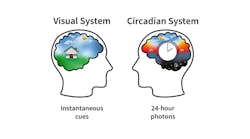The full title of the NEWLED project, which started in November 2012 and will run for 4 years, is “Nanostructured Efficient White LEDs based on short-period superlattices and quantum dots.” The EU will provide EUR 8.4 million (around $11 million) in funding as a contribution to the total project cost of EUR 11.76 million (15.4 million).
The project is led by the University of Dundee, UK, and includes 13 other industrial and academic partners from a range of European countries. The full list can be viewed on the EU project page.
The project aims to develop phosphor-free LED structures with increased brightness (power emitted per surface per angle). If successful, this will avoid power losses due to phosphor conversion, and the problem of different ageing rates of the GaN LED pump.
NEWLED will enhance the efficiency of yellow InGaAlP/AlGaAs LEDs using bandgap-engineered superlattices. These LEDs will replace the phosphor emission that is a normal constituent of phosphor-converted LEDs. Also, novel light-extraction approaches will target advanced directionality and color adjustment.
Values of 50 to 60% overall efficiency with a conversion of greater than 200 lm/W for warm-white LEDs are targeted, along with the realization of a color-rendering index (CRI) of greater than 95. Meanwhile, the team will also investigate advanced packaging to enable effective heat dissipation and light management.
The devices will have immediate applications in automotive, industrial lighting and displays industries. Widespread implementation would reduce global energy consumption by approximately 10% and reduce CO2 emissions by 3 Bn tonnes with consequent economic and environmental benefits.
"Common light bulbs have a pretty low efficiency rating and even the best current white LEDs in use only have an overall efficiency of around 25%," said Professor Edik Rafailov, NEWLED project leader, who is based in the School of Engineering, Physics and Mathematics at Dundee.
"What we are aiming to develop is a significantly more efficient white LED, which would be around 50-60% efficient. If we can do that and it becomes widely adopted, then the effects on energy consumption would be enormous.”




